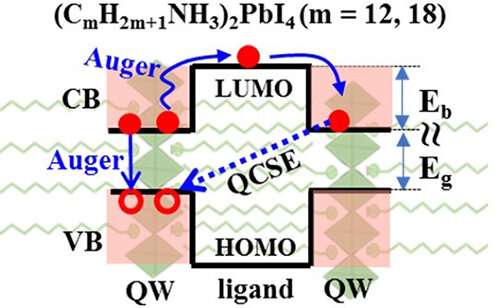Study reveals auger-assisted electron transfer mechanism between adjacent quantum wells in 2D layered perovskites

Two-dimensional (2D) perovskites are multiple quantum well (QW) structures formed by alternating inorganic and organic layers. They are promising in applications of solar cells, LEDs, and photodetectors.
However, due to the energy barrier exerted by the insulating organic ligands between QWs, the photogenerated excitons are usually confined in the perovskite QW plane and exhibit poor interlayer (QW-to-QW) carrier transport. This limits further application of 2D perovskites in optoelectronic devices.
Recently, a research group led by Prof. Jin Shengye from the Dalian Institute of Chemical Physics (DICP) of the Chinese Academy of Sciences (CAS) revealed a new mechanism of Auger-assisted interlayer electron transfer in two-dimensional layered perovskites. It offers a new guideline to design 2D perovskites with an optically tunable QW-to-QW charge transport property.
This work was published in Journal of the American Chemical Society on March 18.
The scientists conducted pump-intensity dependent transient absorption experiments on a series of (CmH2m+1NH3)2PbI4 2D layered perovskites with different ligand alkyl chain lengths (m = 8, 10, 12, 18).
A longer ligand chain (larger m) led to an increased QW band gap energy (Eg) as well as a lower energy barrier (Eb) of electron transfer between the layers. When m≥12, where the value of Eb approaches Eg, a long-lived and derivative-like feature in the transient absorption (TA) spectra was observed. The similar TA spectral feature did not present in short-chain 2D perovskites with m≤12.
The scientists proposed a new Auger-assisted QW-to-QW electron transfer mechanism to explain the experimental results. When Eg ≈ Eb, the Auger recombination of an exciton could pump the electron in another exciton to transfer towards a neighboring QW through the barrier ligands. The separated electrons and holes built up an internal electric field and caused the derivative-like transient spectral feature through a quantum confined Stark effect.
This Auger-assisted electron transfer mechanism can be used to design novel layered 2D perovskites with either improved interlayer charge mobility or tunable optical properties, which may be finally utilized in photoelectronic and optical modulation devices.
More information: Zixi Yin et al. Auger-Assisted Electron Transfer between Adjacent Quantum Wells in Two-Dimensional Layered Perovskites, Journal of the American Chemical Society (2021). DOI: 10.1021/jacs.1c00424
Journal information: Journal of the American Chemical Society
Provided by Chinese Academy of Sciences




















